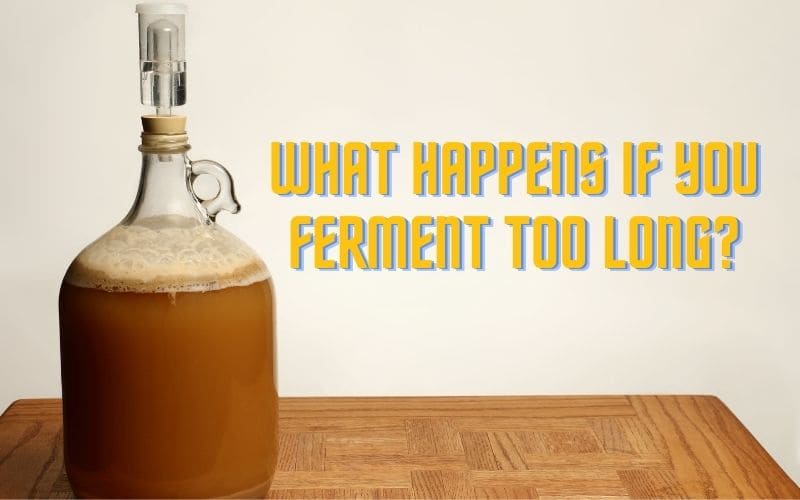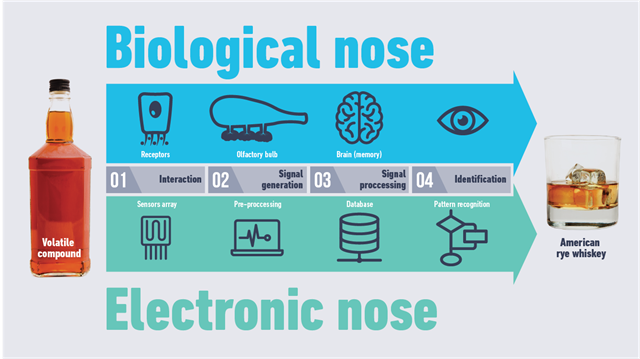What Happens If You Ferment Too Long: Mistakes and How to Avoid Them

Key Takeaways
- Allowing your beer to ferment too long can lead to off-flavors like rubber, sherry-like notes, and vinegar aromas that can ruin your brew.
- The most common signs of over-fermentation include excessive sediment, unintended flavor development, and potential autolysis (yeast cell death) after 3-4 weeks.
- Proper temperature control is critical – high fermentation temperatures accelerate yeast activity and can produce unwanted esters and fusel alcohols.
- Contrary to popular belief, most homebrews can safely remain on primary yeast for 2-3 weeks without negative impacts; the “must rack after 7 days” rule is largely a myth.
- Using proper equipment like airlocks and hydrometers to monitor your fermentation progress is more reliable than simply watching for bubbling activity.
The ticking clock of fermentation can be the homebrew’s best friend or worst enemy. Give your beer too little time, and you’ll miss out on complete attenuation and proper flavor development. But what happens when you leave it too long? Let’s dive into the science and solutions behind extended fermentation periods.
Signs Your Fermentation Has Gone Too Far

“How To Tell When Fermentation Is …” from www.clawhammersupply.com and used with no modifications.
When fermentation extends beyond its optimal window, your brew will send unmistakable signals. These indicators aren’t just about appearance—they’re warnings from the chemical processes happening inside your fermenter.
Off Flavors: Vinegar, Alcohol, and Beyond
The most telling sign of over-fermentation appears in your first sip. Beer that’s been fermenting too long often develops a distinctive sherry-like character—a classic sign of oxidation that occurs when beer sits exposed to even minimal oxygen during extended aging. This becomes especially pronounced in higher-alcohol beers.
Rubbery, meaty, or overly yeasty flavors indicate autolysis—literally, yeast self-digestion. When yeast cells die after extended fermentation periods, they rupture and release compounds that create these unpleasant flavors. While commercial breweries might experience autolysis in just days due to pressure from tall fermenters, homebrewers typically won’t face this issue until the 3-4 week mark or beyond. For those interested in learning more about yeast and its role in fermentation, check out this guide on how much yeast to use for moonshine mash.
Acetic acid (vinegar) flavors signal that aerobic bacteria have likely taken hold. This happens when oxygen exposure combines with contamination during lengthy fermentation, allowing acetobacter to convert alcohol into acetic acid. Once this process begins, it’s nearly impossible to reverse. For more insights into the science behind fermentation, explore the secret history of corn moonshine.
Texture Changes That Signal Trouble
Over-fermented beer often loses body and mouthfeel as yeast continues breaking down complex carbohydrates beyond your intended final gravity. This can leave your beer thin and watery despite starting with a well-crafted grain bill. In extreme cases, beer may develop an astringent quality that causes a puckering sensation on the palate.
Excessive carbonation in the fermenter (not bottles) can also indicate continued fermentation activity well beyond expected completion time. This happens when seemingly dormant yeast finds additional sugars to consume during extended aging periods, creating more CO₂ than anticipated. If you’re curious about how aging affects spirits, you might find this article on aged moonshine packaging ideas interesting.
Visual Indicators of Over-Fermentation
Visually, over-fermented beer often shows excessive sediment beyond what’s normal for the style. While some yeast flocculation is expected, an unusually thick layer at the bottom of your fermenter suggests extensive cell death. The beer might also appear darker than expected as extended aging allows more oxygen interaction, which can darken the color profile over time. When bottle conditioning after extended fermentation, you’ll likely notice significantly more sediment in the bottles than usual—a clear sign of continued yeast activity and cellular breakdown.
The Science Behind Over-Fermentation

“The Science of Fermentation: How Modern …” from www.labmanager.com and used with no modifications.
Understanding what happens microscopically during extended fermentation helps explain why your beer develops unwanted characteristics. The brewing process isn’t static—it’s a dynamic environment where yeast cells live, reproduce, work, and eventually die.
How Yeast and Bacteria Change Over Time
Yeast cells have a finite lifespan, even in the seemingly ideal environment of your fermenter. During normal fermentation, healthy yeast consumes sugars and produces alcohol, CO₂, and desirable flavor compounds. However, after consuming available fermentable sugars (usually within 3-10 days depending on style), yeast enters a dormant phase. For more on fermentation, check out this secret history of corn moonshine.
When left too long, these dormant cells begin to die and rupture through autolysis. The released compounds include fatty acids, amino acids and various proteins that create off-flavors ranging from rubber bands to meat broth. Importantly, even before complete autolysis, aging yeast can reabsorb certain compounds like diacetyl that were produced earlier in fermentation, which explains why some extended aging can actually benefit certain beer styles like lagers that need a “cleanup” period.
Why Temperature Makes or Breaks Your Ferment
Temperature control stands as perhaps the single most critical factor in preventing over-fermentation issues. When fermentation temperatures climb too high, yeast metabolism accelerates dramatically, often producing excessive esters (fruity flavors), higher alcohols (fusel oils), and phenols that create medicinal or band-aid-like characteristics. At elevated temperatures, yeast completes its work much faster but with significantly less precision.
The inverse problem occurs with temperatures that are too low, where yeast becomes dormant rather than completing fermentation. This can lead brewers to mistakenly assume fermentation is “stuck” when it’s merely paused, prompting unnecessary interventions that might eventually result in over-fermentation once temperatures rise. Each yeast strain has specific temperature preferences, with ale yeasts typically working best between 65-70°F (18-21°C) and lager yeasts preferring 50-55°F (10-13°C).
The Role of Sugar Depletion in Extended Ferments
Understanding sugar dynamics helps explain why over-fermentation becomes problematic. In the initial fermentation phase, yeast eagerly consumes simple sugars like glucose and fructose, rapidly converting them to alcohol and CO₂. As these simple sugars deplete, yeast switches to metabolizing more complex sugars like maltotriose, which takes considerably more time and energy. When fermentation extends too long, yeast may begin breaking down compounds you’d prefer to keep intact for body and mouthfeel. For those interested in the specifics of yeast usage, here’s a guide on how much yeast for 5-gallon moonshine mash.
The gradual depletion of fermentable materials forces yeast to metabolize its own reserves or scavenge unconventional food sources, altering your beer’s intended profile. This becomes particularly problematic in high-gravity beers where substantial sugar content can lead to extended fermentation periods that, if not properly managed, cross the line into over-fermentation territory.
Oxygen Exposure: The Silent Fermentation Killer
Oxygen plays a Jekyll-and-Hyde role in brewing. Essential during the wort aeration and early fermentation stages, oxygen becomes fermentation’s enemy during extended aging. Even minuscule oxygen exposure during lengthy fermentation periods can trigger oxidation reactions that produce cardboard, sherry-like, or papery flavors. These reactions accelerate as fermentation extends beyond normal timeframes.
The problem compounds when airlock levels drop due to evaporation or when brewers frequently open fermenters to check progress. Each oxygen introduction creates opportunities for acetobacter contamination, potentially turning your beer towards vinegar production. Proper vessel sealing becomes increasingly critical as fermentation duration extends.
Common Mistakes That Lead to Over-Fermentation

“2,400+ Common Mistakes Stock Photos …” from www.istockphoto.com and used with no modifications.
Most extended fermentation issues stem from preventable errors. Understanding these common pitfalls helps ensure your beer finishes precisely when you intend it to, rather than lingering in fermentation purgatory. For those interested in learning more about the nuances of fermentation, understanding the difference between spirits and moonshine can provide valuable insights.
While some high-gravity or specialty beers genuinely benefit from extended fermentation periods, most homebrewed beers reach their peak condition within a predictable timeframe. Exceeding this window without specific stylistic intention usually creates more problems than benefits, similar to the challenges faced in traditional corn-based moonshine recipes.
Neglecting Temperature Control
Temperature fluctuations represent the most frequent culprit behind extended fermentation problems. When ambient temperatures swing dramatically, yeast activity becomes erratic, alternately speeding up and slowing down metabolism rates. This irregular activity pattern often prolongs fermentation beyond optimal duration, especially when cold periods temporarily halt yeast activity that later resumes.
Many homebrewers make the critical error of fermenting in areas with poor temperature stability like garages or basements without temperature control systems. Without stable temperatures, fermentation schedules become unpredictable, making it difficult to determine when fermentation has truly completed versus when it’s merely slowed temporarily. Using fermentation chambers or temperature-controlled environments prevents this issue entirely.
Forgetting to Check on Your Ferment
The “set and forget” approach proves disastrous for precise fermentation management. Regular gravity readings remain the only reliable method to confirm fermentation completion, yet many brewers rely solely on airlock activity observations. This leads to fermentation extending weeks beyond completion simply because the brewer hasn’t verified final gravity has been reached.
The problem compounds when brewers follow outdated advice suggesting specific timeframes (like “two weeks in primary”) without confirming actual completion through measurements. Without hydrometer readings, brewers can’t determine whether fermentation completed days ago or remains ongoing, potentially pushing beers into the danger zone of extended aging on primary yeast.
Ironically, overly frequent checking creates its own problems by introducing oxygen and potential contaminants with each fermenter opening. The balance lies in scheduled, purposeful gravity readings rather than frequent visual inspections that provide limited useful data.
Using Incorrect Salt Ratios in Vegetable Ferments
While primarily a brewing-focused discussion, it’s worth noting that improper salt concentrations in vegetable fermentations like sauerkraut and kimchi can lead to similar over-fermentation issues. Too little salt fails to properly inhibit harmful bacteria while allowing beneficial lactobacillus to thrive. This imbalance accelerates fermentation beyond control and can lead to mushy textures and overly sour flavors. If you’re interested in fermentation processes, you might also enjoy learning about traditional corn-based moonshine recipes.
The ideal salt concentration for most vegetable ferments ranges from 2-3% by weight. Measuring salt by volume rather than weight creates inconsistency that can contribute to fermentation management problems. Precision matters tremendously in successful fermentation—whether brewing beer or fermenting vegetables.
Poor Sealing and Airlock Problems
Inadequate fermenter sealing creates a deceptive scenario where brewers believe fermentation has stopped because they see no airlock activity, when in reality, CO₂ is simply escaping through leaks rather than the airlock. This misreading of fermentation progress often leads to extended fermenting times as brewers wait for a signal that won’t appear through the intended channel. For those interested in the intricacies of distillation, understanding the main parts of a still can be beneficial in preventing such issues.
Another common airlock issue involves fluid evaporation, which compromises the oxygen barrier and allows unwanted microbes to enter the fermenter. During extended fermentation periods, neglected airlocks may completely dry out, eliminating their protective function entirely. Regular inspection of airlock fluid levels becomes increasingly important as fermentation duration extends.
The Consequences of Letting Ferments Go Too Long

“Consequencias Stock Photos, Royalty …” from depositphotos.com and used with no modifications.
Extended fermentation periods create cascading effects that impact every aspect of your finished beer. Understanding these consequences helps reinforce the importance of proper fermentation management.
Health Risks: When Over-Fermented Food Becomes Unsafe
While over-fermented beer rarely presents significant health risks beyond unpleasant flavors, certain indicators warrant caution. Visible mold growth, particularly varieties displaying black, blue, or pink coloration, signals potential health hazards that shouldn’t be ignored. Slime layers developing on fermenting beer likewise indicate harmful bacterial growth that renders the batch potentially unsafe.
Extreme pH shifts toward alkalinity (above pH 4.6) in fermented products can create environments conducive to dangerous bacterial growth, including botulism in extreme cases. While rare in properly managed fermentations, this risk increases with extended, neglected fermentation periods. When in doubt about safety, remember the homebrewer’s golden rule: “When in doubt, throw it out.”
Flavor Degradation Timeline
Typical Flavor Changes During Extended Fermentation
Days 1-7: Primary fermentation, desirable flavor development
Days 7-14: Maturation, clean-up of fermentation byproducts
Days 14-28: Potential onset of yeasty flavors, beginning of staling
Days 28-42: Increased risk of autolysis flavors (rubber, meat broth)
Days 42+: Significant oxidation, potential for vinegar development
The flavor degradation timeline varies by beer style, yeast strain, and fermentation conditions, but generally follows a predictable pattern. Most homebrewed beers reach optimal flavor within the first 2-4 weeks of fermentation. Beyond this point, quality typically declines rather than improves, particularly for lower-alcohol styles.
Nutritional Changes in Over-Fermented Foods
Extended fermentation periods alter nutritional profiles in ways not always beneficial. While short-term fermentation creates B vitamins and makes certain nutrients more bioavailable, excessive fermentation can degrade these same nutrients. Extended alcohol production may also increase the beer’s caloric content beyond style guidelines, particularly when residual complex sugars are finally broken down during prolonged fermentation.
For sour beers specifically, extended aging increases acidity levels that, while stylistically appropriate, can impact digestive comfort for some consumers. The prolonged presence of certain wild yeasts like Brettanomyces also creates compounds that some find challenging to digest compared to traditional brewer’s yeast fermentation products.
How to Save an Over-Fermented Batch

“Word Save Stock Illustrations – 21,410 …” from www.dreamstime.com and used with no modifications.
Facing an over-fermented batch doesn’t necessarily mean dumping your brew. Several rescue techniques can salvage beer that’s spent too long fermenting.
Blending Techniques to Balance Flavors
Blending remains the professional brewer’s most powerful tool for rescuing over-fermented beer. By combining your over-fermented batch with fresh, under-fermented beer, you can dilute problematic flavors while balancing overall character. The ideal ratio depends on severity—start with 20% fresh beer and adjust to taste.
For particularly strong off-flavors, consider blending with a complementary style rather than a similar beer. For example, an over-fermented stout might blend successfully with a fresh porter, masking autolysis flavors that would remain obvious if blended with another stout. Remember to purge containers with CO₂ when possible during blending to minimize additional oxygen exposure.
When to Cut Your Losses and Start Fresh
Not every over-fermented beer deserves saving. When fermentation extends so long that vinegar characteristics develop, or when obvious contamination appears, cutting losses often makes more sense than rescue attempts. The presence of mold, slime layers, or sewage-like aromas indicates contamination beyond recovery. Similarly, beer exhibiting strong medicinal flavors (from wild yeast phenols) rarely improves through remediation techniques.
Consider the investment already made versus the likelihood of producing enjoyable beer. Sometimes, the learning experience from starting fresh proves more valuable than struggling to rescue a fundamentally flawed batch. Extract the lesson, not necessarily the beer.
Creative Ways to Use Strongly Fermented Products
Before dumping, consider alternative uses for over-fermented beer. Mildly over-fermented batches often make excellent cooking ingredients—beer bread, marinades, and beer-cheese soup mask minor fermentation flaws while contributing positive flavor components. Beer with slight oxidation often works beautifully in beer-battered recipes where subtle sherry notes complement fried foods.
For beer with autolysis flavors, consider distillation if legally permitted in your area. The distillation process separates alcohol from many off-flavors, potentially creating usable spirits from otherwise undrinkable beer. As a last resort, over-fermented beer makes excellent plant fertilizer when diluted—the nutrients from grain and yeast benefit garden plants without affecting their flavor.
Prevention Strategies: Time It Just Right

“Just-In-Time Access: Right Access …” from www.cyberark.com and used with no modifications.
Prevention always beats remediation when managing fermentation timelines. Implementing proper techniques from the start helps ensure your beer ferments exactly as long as intended—no more, no less. For those interested in other fermentation processes, you might explore traditional corn-based moonshine recipes as well.
Essential Equipment for Monitoring Fermentation
- Hydrometer or refractometer for gravity readings
- Thermometer with 0.5°F precision for temperature monitoring
- pH meter for tracking acidity development
- Tasting glasses for sensory evaluation
- Calendar or brewing software for tracking fermentation timeline
- Fresh airlock solution (sanitized water or alcohol)
The hydrometer remains your most reliable tool for determining fermentation completion. When gravity readings remain constant over three consecutive days (typically reaching your recipe’s expected final gravity), fermentation has likely completed regardless of continued airlock activity. This scientific approach prevents both premature packaging and excessive aging.
Ideal Fermentation Timelines by Food Type
Different beer styles have dramatically different optimal fermentation periods. American ales typically complete primary fermentation within 3-7 days and benefit from just 1-2 weeks total fermentation time. German lagers, conversely, require 1-2 weeks of primary fermentation followed by several weeks of cold conditioning for proper flavor development. Belgian styles often benefit from extended fermentation periods of 3-4 weeks to develop complex ester profiles, while sour beers intentionally undergo months or years of controlled fermentation with mixed cultures.
The key distinction lies between controlled, intentional extended fermentation (as with barrel-aging programs) versus unplanned, neglected fermentation that extends simply through oversight. The former creates complexity while the latter typically creates problems. Know your style’s requirements and plan accordingly rather than applying one-size-fits-all fermentation timelines to every brew.
The Refrigeration Method to Halt Fermentation
When your beer reaches terminal gravity but circumstances prevent immediate packaging, cold crashing provides a reliable method to pause fermentation activity. Reducing fermenter temperature to near-freezing (33-38°F/1-3°C) dramatically slows yeast metabolism without creating the off-flavors associated with extended room-temperature aging. This technique buys valuable time—up to several weeks—while preventing continued yeast activity and potential autolysis.
Tasting Schedule: How Often to Check Your Ferments
Develop a systematic tasting schedule that balances information gathering against contamination risk. For standard ales, consider gravity readings and small samples at days 3, 7, and 10, followed by final assessment when gravity stabilizes. This schedule provides trend data without excessive fermenter openings that introduce oxygen. Combine sensory evaluation with gravity measurements to build a complete picture of fermentation progress and prevent unintentional extended fermentation. Learn more about the three main parts of a still to enhance your brewing setup.
Mastering the Art of Perfect Fermentation

“Mastering Fermentation: 100+ Homemade …” from www.amazon.com and used with no modifications.
Truly skilled brewers develop intuition about fermentation timing that combines scientific measurement with experience-based judgment. This mastery comes from consistent practice, meticulous record-keeping, and attention to detail throughout the brewing process.
- Start with proper pitch rates to ensure healthy fermentation
- Maintain stable fermentation temperatures appropriate to your yeast strain
- Monitor gravity decline rather than relying on airlock activity
- Package promptly when final gravity stabilizes unless style demands extended aging
- Adjust processes based on documented results from previous batches
The goal isn’t necessarily the shortest possible fermentation time but rather the optimal duration for your specific beer style. Some styles genuinely benefit from extended conditioning periods, while others reach peak quality quickly and then decline. Understanding these style-specific requirements comes from both research and personal experience.
Temperature management throughout fermentation significantly impacts both duration and quality. Investing in temperature control equipment pays dividends through consistent fermentation timelines and reliable flavor development. Even simple solutions like water baths with frozen bottles can dramatically improve fermentation management compared to uncontrolled environments.
Keep a Fermentation Journal for Future Success
Documentation creates the foundation for fermentation mastery. Record not just recipes but fermentation observations: gravity readings, temperature fluctuations, visual changes, and tasting notes throughout the process. These records reveal patterns that might otherwise remain invisible, helping you recognize when fermentation extends beyond optimal duration. For those interested in traditional methods, consider trying a corn-based moonshine recipe to document your process.
Many excellent brewing applications exist for digital record-keeping, but even simple paper journals provide valuable historical data. The key elements to record include pitch date, starting gravity, temperature readings, gravity measurements with dates, tasting notes, packaging date, and post-packaging observations.
- Note visible fermentation stages (lag, high krausen, settling)
- Record specific off-flavors if they develop
- Document ambient temperature fluctuations that might impact fermentation
- Track gravity decline to identify potential stalling or completion
- Compare similar recipes to identify patterns in fermentation behavior
This systematic approach transforms brewing from guesswork into controlled craft, preventing the accidental extended fermentation periods that lead to flavor degradation. Over time, your journal becomes an invaluable reference that helps predict optimal fermentation duration for your specific brewing setup and preferred styles. If you encounter issues, consider troubleshooting homebrew mistakes to refine your process further.
Seasonal Adjustments for Consistent Results
Environmental factors significantly impact fermentation timing, requiring seasonal adjustments to maintain consistency. Summer brewing often demands additional cooling methods to prevent accelerated fermentation that completes too quickly and potentially produces off-flavors. Conversely, winter brewing may require heating elements to prevent stalled fermentation that appears complete but later resumes, creating over-fermentation issues. Recognize these seasonal patterns and adjust your process accordingly rather than following identical procedures year-round.
Frequently Asked Questions
After helping countless brewers address fermentation timing issues, certain questions arise repeatedly. These answers address the most common concerns about extended fermentation periods.
Can I still drink beer that has fermented too long?
Generally, beer that has fermented too long remains safe to drink despite potential flavor flaws. The low pH and alcohol content create an environment hostile to truly harmful pathogens. However, palatability becomes the primary concern—beer with strong autolysis flavors (rubber, meaty, yeasty) or significant oxidation (cardboard, sherry) might be technically safe but unpleasant to consume. Use your senses: avoid consuming any fermented beverage with visible mold, slime layers, or sewage-like aromas, but don’t fear merely unpalatable flavors from extended fermentation.
How do I know when fermentation is complete but not excessive?
- Gravity readings match expected final gravity for your recipe
- Measurements remain stable for three consecutive days
- Visible fermentation signs have subsided (minimal krausen, clearer beer)
- Flavor profile matches style expectations without autolysis characters
- Beer has reached typical fermentation duration for style (generally 1-3 weeks for most ales)
Complete fermentation doesn’t always coincide with total clearing—many beers benefit from additional cold conditioning to improve clarity after fermentation completes. However, extended aging at fermentation temperatures rather than cold conditioning temperatures increases the risk of flavor degradation.
The myth that beer must be removed from yeast after 1-2 weeks to prevent autolysis has been largely debunked for homebrew-scale operations. Commercial breweries with tall fermenters experience yeast autolysis pressure much sooner than homebrewers using carboys or buckets. Most homebrewed beers safely remain on yeast for 3-4 weeks without developing significant off-flavors from autolysis.
That said, prompt packaging after confirmed fermentation completion (through gravity measurements) generally produces better results than extended aging in primary fermenters, particularly for lower-alcohol styles. High-alcohol styles (above 8% ABV) often benefit from extended aging periods that would be detrimental to lighter beers.
Trust your hydrometer over bubbling airlock activity. Many factors can cause continued CO₂ release even after fermentation completes, including temperature fluctuations that release dissolved CO₂, wild yeast working on complex sugars, or simply leaky seals that create the illusion of ongoing fermentation. For those interested in traditional methods, you might want to explore a traditional corn-based moonshine recipe to understand the nuances of fermentation.
What’s the difference between normal fermentation bubbles and signs of spoilage?
Normal fermentation produces relatively uniform bubbles that form a consistent pattern, while contamination often creates irregular bubbling after primary fermentation should have completed. Particularly concerning are pellicle formations—wrinkly, skin-like surfaces that develop on beer and indicate wild yeast or bacterial presence. While some wild fermentations intentionally develop pellicles (as in lambic production), their unexpected appearance in conventional beer typically signals contamination that will extend fermentation unpredictably.
Can I restart a fermentation that has gone too far?
Once fermentation extends to the point of developing autolysis or significant oxidation flavors, these chemical changes cannot be reversed through additional fermentation. However, blending with fresh beer often proves more successful than attempting to “fix” the batch through additives or additional yeast. For beer that’s developed extreme acidity from extended mixed fermentation, small amounts of food-grade calcium carbonate can reduce acidity, though this approach works better for intentional sour beers than contaminated conventional beers.
Why does my beer taste alcoholic after fermenting for weeks?
Extended fermentation periods sometimes create elevated fusel alcohol levels that present as harsh, solvent-like flavors rather than clean ethanol. These higher alcohols form through alternative metabolic pathways when yeast experiences stress, including the stress of depleted nutrients during extended fermentation periods. The perception of “hot” alcohol character often increases as other flavor components diminish during extended aging.
Fusel production accelerates at higher fermentation temperatures, which explains why this issue frequently accompanies uncontrolled fermentation environments. While some fusel character may diminish with extended cold conditioning, prevention through proper fermentation temperature management and appropriate fermentation duration remains more effective than remediation.
- Maintain fermentation temperatures within recommended range for your yeast strain
- Ensure adequate yeast nutrition through proper wort preparation
- Package beer promptly when gravity readings indicate complete fermentation
- Consider cold conditioning to smooth any minor fusels that developed during primary fermentation
- For future batches, adjust yeast pitch rates appropriate to your beer’s gravity
Remember that every fermentation follows a unique timeline influenced by wort composition, yeast health, temperature, and numerous other factors. Developing intuition for your brewing system’s typical patterns helps prevent unintentional extended fermentation while allowing for intentional extended aging when stylistically appropriate. For more on fermentation, you might find the traditional corn-based moonshine recipe an interesting read.
With consistent attention to fermentation signs and systematic monitoring practices, you’ll develop the judgment to determine precisely when fermentation has reached completion without extending into problematic territory. The boundary between beneficial conditioning and detrimental aging often comes down to just days, making careful monitoring essential to brewing success. For those interested in traditional methods, consider exploring a traditional corn-based moonshine recipe to refine your fermentation skills.
The most successful homebrewers maintain a balance—scientific enough to measure fermentation progress accurately yet flexible enough to adapt processes based on what each specific batch requires. This combination of precision and intuition prevents the fermentation timing mistakes that compromise otherwise excellent beer.




